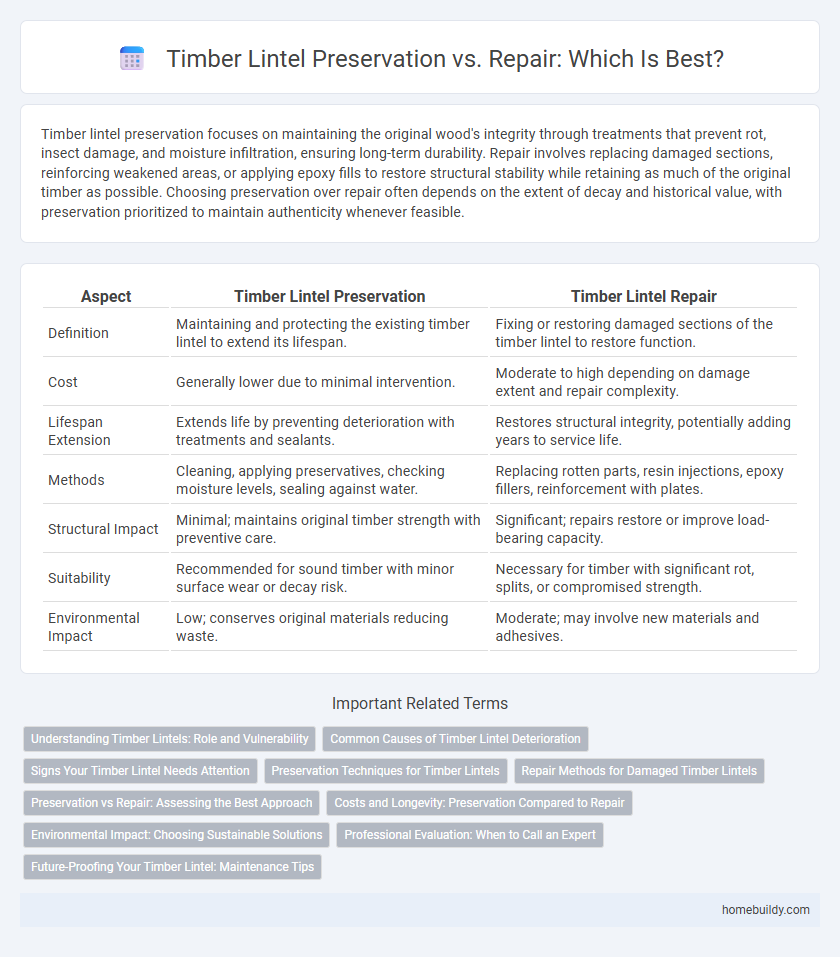Timber lintel preservation focuses on maintaining the original wood's integrity through treatments that prevent rot, insect damage, and moisture infiltration, ensuring long-term durability. Repair involves replacing damaged sections, reinforcing weakened areas, or applying epoxy fills to restore structural stability while retaining as much of the original timber as possible. Choosing preservation over repair often depends on the extent of decay and historical value, with preservation prioritized to maintain authenticity whenever feasible.
Table of Comparison
| Aspect | Timber Lintel Preservation | Timber Lintel Repair |
|---|---|---|
| Definition | Maintaining and protecting the existing timber lintel to extend its lifespan. | Fixing or restoring damaged sections of the timber lintel to restore function. |
| Cost | Generally lower due to minimal intervention. | Moderate to high depending on damage extent and repair complexity. |
| Lifespan Extension | Extends life by preventing deterioration with treatments and sealants. | Restores structural integrity, potentially adding years to service life. |
| Methods | Cleaning, applying preservatives, checking moisture levels, sealing against water. | Replacing rotten parts, resin injections, epoxy fillers, reinforcement with plates. |
| Structural Impact | Minimal; maintains original timber strength with preventive care. | Significant; repairs restore or improve load-bearing capacity. |
| Suitability | Recommended for sound timber with minor surface wear or decay risk. | Necessary for timber with significant rot, splits, or compromised strength. |
| Environmental Impact | Low; conserves original materials reducing waste. | Moderate; may involve new materials and adhesives. |
Understanding Timber Lintels: Role and Vulnerability
Timber lintels serve as critical structural supports above window openings, bearing significant loads from masonry and preventing wall collapse. Their vulnerability arises from exposure to moisture, insect infestation, and rot, which can compromise structural integrity over time. Effective preservation involves regular inspection, moisture control, and targeted treatment, whereas repair often requires partial or full replacement of damaged sections to restore strength and function.
Common Causes of Timber Lintel Deterioration
Timber lintels commonly deteriorate due to prolonged exposure to moisture, leading to rot and fungal decay, as well as insect infestations like woodworm or termites. Inadequate ventilation and poor maintenance accelerate these issues, compromising structural integrity and causing sagging or cracking over time. Preservation focuses on preventing moisture ingress and applying protective treatments, while repair often involves replacing severely damaged sections to restore strength.
Signs Your Timber Lintel Needs Attention
Timber lintels showing signs of rot, cracking, or sagging indicate urgent need for preservation or repair to maintain structural integrity. Moisture accumulation and insect infestation are common causes of timber decay that require immediate professional assessment. Early detection through visual inspection and tapping tests can prevent costly replacements by enabling timely treatment or reinforcement.
Preservation Techniques for Timber Lintels
Preservation techniques for timber lintels include applying protective coatings such as borate preservatives to prevent fungal decay and insect infestation. Regular inspections and controlled moisture levels help maintain wood integrity, reducing the risk of rot and structural failure. Installing flashing and ensuring proper drainage around the lintel further protects it from water damage and extends its lifespan.
Repair Methods for Damaged Timber Lintels
Repair methods for damaged timber lintels include epoxy resin injection, which restores structural integrity by filling cracks and reinforcing weakened areas. Steel or timber sistering involves attaching new timber or steel plates alongside the existing lintel to provide additional support while preserving most of the original material. Installing corrosion-resistant metal straps or brackets can also improve load distribution and prevent further deterioration in compromised timber lintels.
Preservation vs Repair: Assessing the Best Approach
Preserving timber lintels is essential for maintaining structural integrity and historical value, often involving careful cleaning, treating against rot, and applying protective coatings to extend lifespan. Repairing damaged timber lintels typically includes splicing or reinforcing compromised sections with matching materials to restore strength without complete replacement. Assessing the best approach requires evaluating the extent of decay, structural safety, and cost-effectiveness while prioritizing material conservation and longevity.
Costs and Longevity: Preservation Compared to Repair
Preserving timber window lintels often incurs lower initial costs compared to full repairs, as it avoids extensive material replacement and labor. Preservation methods, such as treating and sealing, can extend the lintel's lifespan by up to 20 years, while repairs, especially structural replacements, typically ensure longevity beyond 30 years but demand higher investment. Investing in preservation balances cost-efficiency with moderate durability, whereas repair guarantees longer-term resilience at increased expense.
Environmental Impact: Choosing Sustainable Solutions
Timber lintel preservation reduces environmental impact by extending the lifespan of existing wood, minimizing the need for new raw materials and lowering carbon emissions associated with manufacturing and transportation. Repairing timber lintels often requires partial replacement, generating waste and increasing resource consumption, whereas preservation techniques like treatment and reinforcement promote sustainability. Opting for preservation aligns with green building practices by maintaining structural integrity while conserving natural resources and reducing the overall ecological footprint.
Professional Evaluation: When to Call an Expert
Professional evaluation is crucial for timber lintel preservation versus repair because experts can accurately assess structural integrity and identify early signs of decay or insect damage. A certified structural engineer or conservation specialist should be consulted when visible cracks, sagging, or moisture exposure occur to determine if preservation techniques suffice or if replacement is necessary. Timely expert intervention ensures the longevity of the timber lintel while preventing costly structural failures.
Future-Proofing Your Timber Lintel: Maintenance Tips
Regular inspection and treatment of timber lintels with preservatives prevent rot and insect damage, extending their lifespan significantly. Applying water-resistant coatings and ensuring proper drainage around the lintel reduces moisture penetration, a common cause of timber deterioration. Timely repairs of minor cracks and splits with epoxy resin or wood filler maintain structural integrity and protect against future decay.
timber lintel preservation vs repair Infographic

 homebuildy.com
homebuildy.com